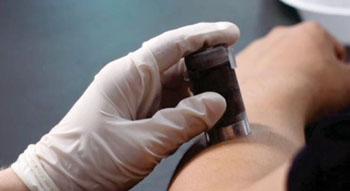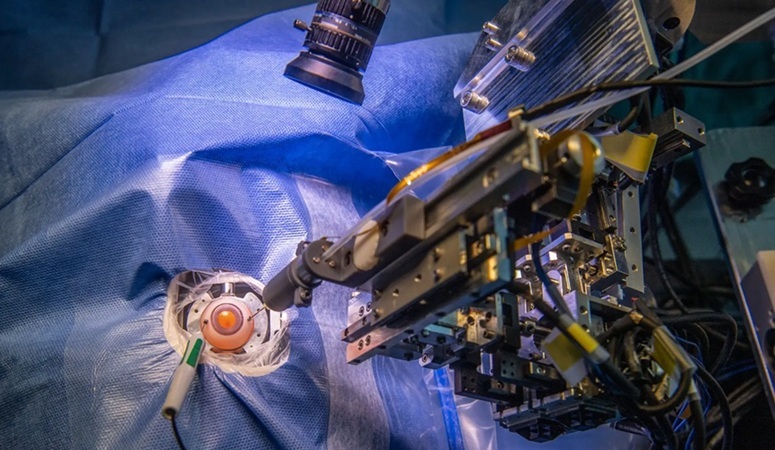Novel Device Eases the Pain of Injections 
|
By HospiMedica International staff writers Posted on 28 Apr 2015 |

Image: The Comfortably Numb device (Photo courtesy of Rice University).
A novel prototype device numbs the skin prior to an injection by producing a rapid chemical reaction that cools the patient’s skin.
Developed by a team of freshman engineering students at Rice University (Rice, Houston, TX, USA), the “Comfortably Numb” device consists of two sealed, separated chambers containing ammonium nitrate and water. A simple twisting motion moves the chambers into an alignment that allows the chemicals to flow together through the chamber, producing a rapid endothermic reaction. The device’s metal surface plate is then pressed against the skin, producing a numbing effect.
The functioning prototype of the device has been shown to produce a measurable numbing effect in just 60 seconds. The device was also designed as single-use rather than reusable, since cleaning it for each patient and resetting the chambers would be time-consuming and cumbersome. The design team is currently in the process of applying for a provisional patent for the device, and hopes to continue their work together in their spare time when they return to Rice as sophomores.
“We are targeting anyone who has to get an injection, which is nearly everyone. But the device is especially applicable to people who are more susceptible to pain, such as the elderly and children,” said design team member computer science major Greg Allison. “It’s intended for use during procedures where you have to get shots in more sensitive areas of the body, such as the face or the groin.”
“We looked into all sorts of methods for numbing, both quick and long-term, chemicals, using ice packs, which is similar to what we’re using now,” added team member mechanical engineering major Mike Hua. “We explored everything that surrounded the problem before we even began brainstorming. At the end of the day, what we’re creating is a self-contained device with a very cold contact surface, and there are many applications for that.”
Related Links:
Rice University
Developed by a team of freshman engineering students at Rice University (Rice, Houston, TX, USA), the “Comfortably Numb” device consists of two sealed, separated chambers containing ammonium nitrate and water. A simple twisting motion moves the chambers into an alignment that allows the chemicals to flow together through the chamber, producing a rapid endothermic reaction. The device’s metal surface plate is then pressed against the skin, producing a numbing effect.
The functioning prototype of the device has been shown to produce a measurable numbing effect in just 60 seconds. The device was also designed as single-use rather than reusable, since cleaning it for each patient and resetting the chambers would be time-consuming and cumbersome. The design team is currently in the process of applying for a provisional patent for the device, and hopes to continue their work together in their spare time when they return to Rice as sophomores.
“We are targeting anyone who has to get an injection, which is nearly everyone. But the device is especially applicable to people who are more susceptible to pain, such as the elderly and children,” said design team member computer science major Greg Allison. “It’s intended for use during procedures where you have to get shots in more sensitive areas of the body, such as the face or the groin.”
“We looked into all sorts of methods for numbing, both quick and long-term, chemicals, using ice packs, which is similar to what we’re using now,” added team member mechanical engineering major Mike Hua. “We explored everything that surrounded the problem before we even began brainstorming. At the end of the day, what we’re creating is a self-contained device with a very cold contact surface, and there are many applications for that.”
Related Links:
Rice University
Latest Critical Care News
- CPR Guidelines Updated for Pediatric and Neonatal Emergency Care and Resuscitation
- Ingestible Capsule Monitors Intestinal Inflammation
- Wireless Implantable Sensor Enables Continuous Endoleak Monitoring
- Pulse Oximeter Index Offers Non-Invasive Guides for Fluid Therapy
- Wearable Patch for Early Skin Cancer Detection to Reduce Unnecessary Biopsies
- 'Universal' Kidney to Match Any Blood Type
- Light-Based Technology to Measure Brain Blood Flow Could Diagnose Stroke and TBI
- AI Heart Attack Risk Assessment Tool Outperforms Existing Methods
- Smartphone Imaging System Enables Early Oral Cancer Detection
- Swallowable Pill-Sized Bioprinter Treats GI Tract Injuries

- Personalized Brain “Pacemakers” Could Help Patients with Hard-To-Treat Epilepsy
- Microscopic DNA Flower Robots to Enable Precision Medicine Delivery
- Origami Robots to Deliver Medicine Less Invasively and More Effectively
- Improved Cough-Detection Technology Aids Health Monitoring
- AI Identifies Children in ER Likely to Develop Sepsis Within 48 Hours
- New Radiofrequency Therapy Slows Glioblastoma Growth
Channels
Surgical Techniques
view channel
Robotic Assistant Delivers Ultra-Precision Injections with Rapid Setup Times
Age-related macular degeneration (AMD) is a leading cause of blindness worldwide, affecting nearly 200 million people, a figure expected to rise to 280 million by 2040. Current treatment involves doctors... Read more
Minimally Invasive Endoscopic Surgery Improves Severe Stroke Outcomes
Intracerebral hemorrhage, a type of stroke caused by bleeding deep within the brain, remains one of the most challenging neurological emergencies to treat. Accounting for about 15% of all strokes, it carries... Read morePatient Care
view channel
Revolutionary Automatic IV-Line Flushing Device to Enhance Infusion Care
More than 80% of in-hospital patients receive intravenous (IV) therapy. Every dose of IV medicine delivered in a small volume (<250 mL) infusion bag should be followed by subsequent flushing to ensure... Read more
VR Training Tool Combats Contamination of Portable Medical Equipment
Healthcare-associated infections (HAIs) impact one in every 31 patients, cause nearly 100,000 deaths each year, and cost USD 28.4 billion in direct medical expenses. Notably, up to 75% of these infections... Read more
Portable Biosensor Platform to Reduce Hospital-Acquired Infections
Approximately 4 million patients in the European Union acquire healthcare-associated infections (HAIs) or nosocomial infections each year, with around 37,000 deaths directly resulting from these infections,... Read moreFirst-Of-Its-Kind Portable Germicidal Light Technology Disinfects High-Touch Clinical Surfaces in Seconds
Reducing healthcare-acquired infections (HAIs) remains a pressing issue within global healthcare systems. In the United States alone, 1.7 million patients contract HAIs annually, leading to approximately... Read moreHealth IT
view channel
Printable Molecule-Selective Nanoparticles Enable Mass Production of Wearable Biosensors
The future of medicine is likely to focus on the personalization of healthcare—understanding exactly what an individual requires and delivering the appropriate combination of nutrients, metabolites, and... Read moreBusiness
view channel
Philips and Masimo Partner to Advance Patient Monitoring Measurement Technologies
Royal Philips (Amsterdam, Netherlands) and Masimo (Irvine, California, USA) have renewed their multi-year strategic collaboration, combining Philips’ expertise in patient monitoring with Masimo’s noninvasive... Read more
B. Braun Acquires Digital Microsurgery Company True Digital Surgery
The high-end microsurgery market in neurosurgery, spine, and ENT is undergoing a significant transformation. Traditional analog microscopes are giving way to digital exoscopes, which provide improved visualization,... Read more
CMEF 2025 to Promote Holistic and High-Quality Development of Medical and Health Industry
The 92nd China International Medical Equipment Fair (CMEF 2025) Autumn Exhibition is scheduled to be held from September 26 to 29 at the China Import and Export Fair Complex (Canton Fair Complex) in Guangzhou.... Read more














